Seasons > Easter > Easter Decorations for the Church > Easter Vignettes for the Church
Many churches are not decorated until Easter Sunday, then a few potted lilies are put around the platform as the only Easter decoration. That seems so pitiful for celebrating the greatest day in history--the day Jesus rose from the dead, and salvation became available for every human being who ever has lived or will live!! Christmas, celebrating Jesus’ birth, usually has lots of decorations, and they are displayed for a month! Christmas would be meaningless if there were no Easter with the resurrection miracle! Why not decorate the church in such a way as to make your members stop and think, “Wow, this is a really important day--this is worth celebrating!”
Make meaningful decorations by studying the last week of Jesus’ life and the events that lead up to the resurrection. Then find reasonable facsimiles of objects in those stories and group them together on tables or shelves around the church. These can simply be visual reminders of the events, or they can become an interactive activity, to help people think about what they are seeing. I have several ways to do this at the end of the second page.


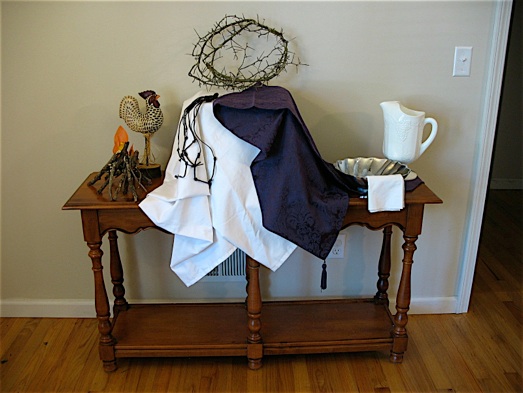
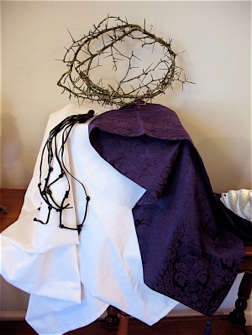


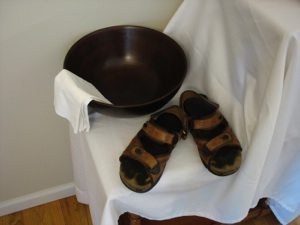

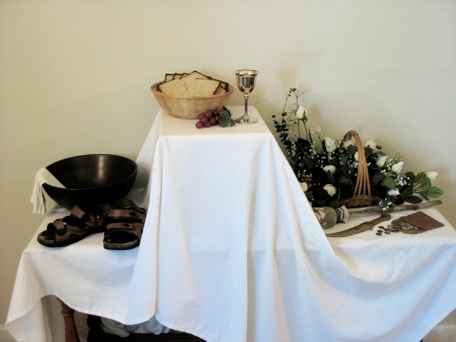
The rooster and campfire depict the trial before the Sanhedrin when Peter denied Jesus 3 times before the cock crowed. If you can’t find a chicken or rooster decoration, get an artistic adult or child to make one out of paper mache. To make the fire, glue or wire sticks together, and cut flames out of tissue paper. The campfire could also be used as a vignette representing the resurrection appearance when Jesus cooked breakfast by the side of the lake--just replace the rooster with a fish.
Jesus was stripped of his clothes and whipped with a scourge. Then the soldiers put a royal purple robe and crown of thorns on him. The purple robe is simply a table runner, and the white garment a sheet. This scourge was made out of a dollar store braided belt. I cut the buckle off and tied knots in the strands. To make it more realistic, glue bent nails into each knot.
Pilot washed his hands to symbolize that it was not his fault that Jesus was crucified. Ask around to see if any of your church members will lend a bowl or pitcher that might be fancy enough to represent what Pilot might have used. Write “Jesus, King of the Jews” on an old board to represent the plaque placed on the cross to label the “crime” that was committed.

The bowl and sandals represent Jesus washing the disciples’ feet during the last supper. Any leather sandals will do, but occasionally you can find roman looking sandals. Buy a pair in any size, even if they don’t have a size that fits you, or buy them in a size of a Sunday school teacher or someone who might use them in a church play. Try to find a large bowl that is wooden or stoneware or metal rather than plastic or glass. For the same reason, a plain cotton towel would be better than a terry cloth towel.
These objects depict the last supper. The matos was purchased at Walmart, believe it or not! Some Walmart stores sell matzos year round, while others sell them only before Passover, and some don’t sell them at all, so shop around. Another option is to look for a store that sells Kosher food. Or you can make your own. The grapes are fake (less worrisome than having grapes rot, or worse, eaten!) and were purchased at a dollar store. Jesus was not likely to have used a goblet, so a handleless ceramic cup would be more realistic. But a goblet has become a symbol, so if you have one, use it if you want (but not if it is glass--that is stretching it a little too far.)
These objects stand for the Garden of Gethsemane. The pouch with 30 silver coins represents Judas’ betrayal. The stick with a washcloth tied around it represents the torches the soldiers probably carried to find Jesus in the dark. The knife symbolizes the sword that Peter used to cut off the servant’s ear. A large metal sword may be hard to find unless one of your church members happens to own a sword collection. A toy sword will work (and be less dangerous for anyone who can’t resist touching.) Make your own leather pouch by folding a strip of leather in thirds, and punch holes in the sides. Thread strips of leather or string through the holes to form a pouch. Use plastic coins if you are worried someone might steal real ones. Or have a bowl of foil covered chocolate coins for anyone who does the activity for that vignette.
Tips for making displays:
-
1.Get the biggest objects you can find. Since distances can be quite long in churches, people will not even notice, let alone make out what the objects are, if they are small.
-
2.Try to get objects made of materials that would have been used 2000 years ago. For example, use a wooden or stoneware bowl, not a plastic bowl, if you can find one.
-
3.Add interest by varying the height of the objects. You can add height by putting some of the objects on a wooden box or stool. If they don’t look good as is, drape a sheet or tablecloth over them.
-
4.Keep rearranging the items until they have a pleasing affect. If you don’t feel confident doing this by yourself, get a friend or two to help you out.
-
5.Use the wall to hang pictures or objects for a combined display with bigger impact. Sometimes Christian calendars have artwork that is perfect for this--and not too expensive.
Jesus’ Trials
The Last Supper and Garden of Gethsemane

Jesus’ trials before the Sanhedrin, and Pilot
Seasons > Easter > Easter Decorations for the Church > Easter Vignettes for the Church
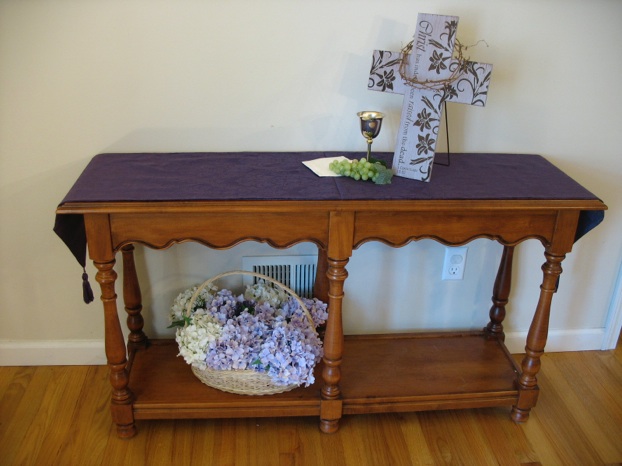
Here is rather simple, yet effective version of the display. The goblet, grapes, and matzos represent the Last Supper, The crown of thorns and a purple table runner reminds us of Jesus’ trial. The cross stands for Jesus’ work of salvation on the cross. The flowers symbolize the new life we have because of the resurrection. Hopefully these examples have inspired you to see objects in a whole new way! Who knew your husband’s old sandals, your favorite wooden bowl, and Grandma’s table runner you never used, could all be combined to make an Easter display!


